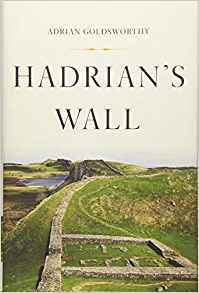 Adrian Goldsworthy, Hadrian's Wall (New York: Basic Books, 2018), 169pp.
Adrian Goldsworthy, Hadrian's Wall (New York: Basic Books, 2018), 169pp.
In the last several years my wife and I have enjoyed a number of long walks, including the 500-mile Camino Santiago in Spain, the 458-mile pilgrimage across southern France called Le Chemin du Puy, and the 350-mile La Via di Francesco from Florence to Assisi to Rome. But there is one famous walk that we have always talked about but never done — the 84 miles from coast to coast in northern England that follow the World Heritage Site of Hadrian's Wall.
This book is the perfect introduction to the wall walk: it's short, it's written by an award-winning historian of the classical world, and it's about an inherently fascinating subject. Orphaned at the age of ten when his father died, Hadrian (76–138 AD) became emperor of the empire's sixty million people in the year 117 when he was forty-one. Construction on the Wall began in AD 122 and continued until his death, although various refinements continued for decades. The Wall was used for some 300 years. By the early fifth century, the "Roman state had ceased to function in Britain, so that effectively it had ceased to be part of the empire."
Hadrian was as an architectural enthusiast (if amateur who irritated the experts), although as Goldsworthy shows, the Wall was more than a vanity project, an architectural statement, the end point of civilization and the beginning of barbarism, or even a "customs barrier." Rather, the wall was built to serve the Roman military: "Soldier's were not there to serve the Wall, but the Wall was there to serve them." It was a "formidable obstacle to unauthorized movement" at the edge of the empire. It forced travelers to pass through a milecastle or fort, helped the military to monitor its border, enabled the state to refuse entry, and allowed the empire to levy tolls and taxes as it saw fit.
Goldsworthy explores every aspect of the Wall: Hadrian the man, how the Wall was built and manned, how the Wall functioned, the "anatomy" of the Wall that included a deep ditch 28 feet wide and 9 feet deep, various forts and "fortlets," and what life was like on the Wall for both soldiers and civilians. The Wall was a military zone, and so it was also a place of towns, traders, businesses, shops, taverns, bars, workshops, temples, granaries and hospitals. Goldsworthy sifts through the "meagre literary sources," the history of the Wall's many excavations, the archaeology, and artifacts. He does so in a way that eliminates the myths but retains the magic of a bygone era.
For more on this subject see my review of the book by Anthony Everitt, Hadrian and the Triumph of Rome (New York: Random House, 2009), 392pp.


